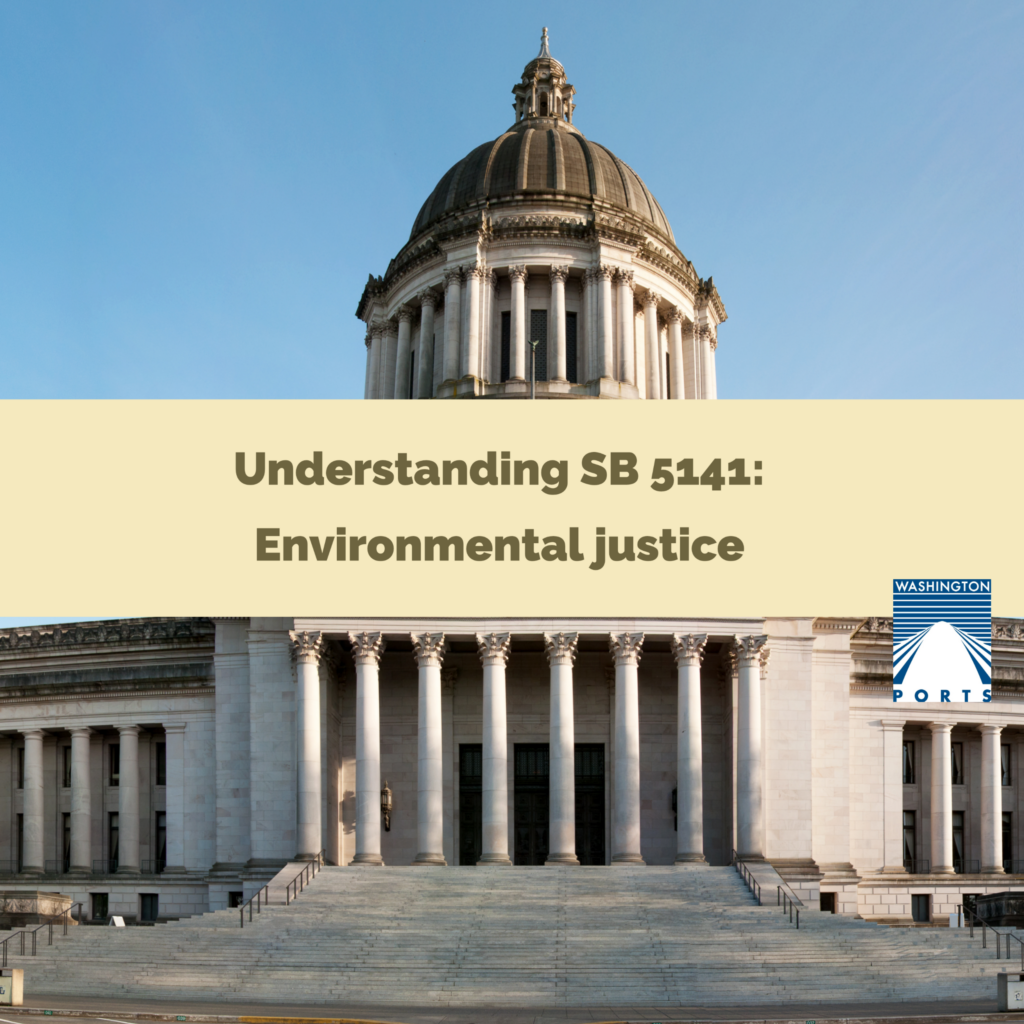
By Gerry o’Keefe
Senior Director of Environmental Affairs
Last fall state Legislative leadership identified equity policies as a top tier priority for the 2021 Session. As we have previously noted, environmental justice is included among these priorities. We prepared the following summary of Senate Bill 5141 to inform our members regarding the content of the bill. We expect the debate to continue and the bill to evolve. The Washington Public Ports Association has not taken a position on this legislation.
Brief Summary and Definitions – PSSB 5141. The bill establishes environmental justice strategic plan incorporation, equitable community engagement and public participation, tribal consultation, performance assessment, and budget and funding obligation requirements for the Departments of Health, Ecology, Agriculture, Natural Resources, Commerce, and Transportation, and the Puget Sound Partnership.
It establishes the Environmental Justice Council to adopt guidelines and provide technical assistance to support agency environmental justice work, review agency implementation of environmental justice obligations, and make recommendations on existing laws and proposed legislation to further environmental justice goals.
Environmental justice is defined as the fair treatment and meaningful involvement of all people regardless of race, color, national origin, or income with respect to the development, implementation, and enforcement of environmental laws, regulations, and policies. This includes addressing disproportionate environmental and health impacts by prioritizing vulnerable populations and overburdened communities, equitably distributing resources and benefits, and eliminating harm.
Overburdened communities are areas identified through a cumulative environmental health impact analysis with a high concentration of members of a vulnerable population that potentially experience disproportionate health and environmental harms and risks. Vulnerable populations are communities that experience a disproportionate, cumulative risk from environmental harms due to adverse socioeconomic factors, sensitivity factors, and negative public health factors that increase vulnerability to the effects of environmental harms.
Specific Elements of the PSSB 5141.
Incorporation of Environmental Justice Component in Strategic Plans. As part of each agency’s strategic plan, each agency must include an environmental justice implementation plan within one year of the effective date of the act.
Equitable Community Engagement and Public Participation. An agency must create and adopt a community engagement plan that describes how it will engage with overburdened communities and vulnerable populations as it evaluates new and existing activities and programs.
Overburdened communities are areas identified through a cumulative environmental health impact analysis with a high concentration of members of a vulnerable population that potentially experience disproportionate health and environmental harms and risks. Vulnerable populations are communities that experience a disproportionate, cumulative risk from environmental harms due to adverse socioeconomic factors, sensitivity factors, and negative public health factors that increase vulnerability to the effects of environmental harms.
Tribal Consultation. An agency must consult with Indian tribes on all significant agency actions, programs, and on the distribution of state funds that affect Indian tribes’ rights and interests in their tribal lands.
Environmental Justice Assessment. When considering a significant agency action, an agency must conduct an environmental justice assessment to better inform the agency in making its decision and to assist the agency with the equitable distribution of environmental benefits, reduction of environmental harms, and the identification and reduction of racial and economic disparities.
Significant agency action includes the adoption of significant legislative rules, agency budgets, the making of major investments and resource allocations, legislation concerning agency duties, and any decision or activity that may cause environmental harm to overburdened communities or vulnerable populations.
Agency Budgets and Funding. State agencies must incorporate environmental justice principles into decision processes for budget development, making investments, granting or withholding benefits, and distributing funding in order to direct funding and investments towards overburdened communities and vulnerable populations. In making these decisions an agencies must:
· direct environmental benefits to reduce statewide disparities, including the disparities that a specific community experiences and those based on geography, race, or ethnicity;
· focus investments on creating environmental benefits;
· ensure meaningful participation in spending and investment decisions; promote transparency with clear goals and assessment metrics; and,
· establish a goal of 40 percent and no less than 35 percent of investments that create environmental benefits directed to vulnerable populations in overburdened communities.
Reporting. By September 1st of each year, each agency must publish a dashboard report or an updated dashboard report, in a uniform dashboard format on the Office of Financial Management’s website, delineating its progress on the environmental justice implementation component of its strategic plan and its environmental justice assessments of proposed significant agency actions. Environmental Health Disparities Map.
Cumulative environmental health impact is defined as the combined, multiple environmental harms and health impacts on a vulnerable population.
Environmental Justice Council. The council’s powers and duties include:
· review of agency implementation of environmental justice requirements under the act;
· adoption of guidelines describing best practices and provision of technical guidance for agencies to achieve compliance with the act, engage with vulnerable populations, and meet the needs of overburdened communities;
· providing information concerning agency compliance;
· creating a process to audit agency performance;
· reviewing agency reporting dashboards;
· making recommendations for additional legislation to further environmental justice goals of the state; and,
· providing an annual update of the council’s work to the appropriate committees of the Legislature.
Environmental Justice Advocate. The EJA would have the power to initiate and attempt to resolve an investigation of agency compliance upon its own initiative or upon receipt of a complaint from a representative or member of an overburdened community, the council, or others. The advocate holds the office for a term of three years and continues to hold office until reappointed or until a successor is appointed. A statutory term of service is unusual. Gubernatorial appointments, with the exception of board members or commissioners, serve at the pleasure of the governor. There may be other exceptions which are not widely understood.





